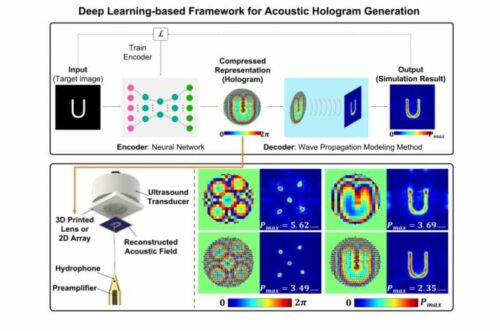Researchers have developed deep learning based methods to generate holograms using focused ultrasound in real time.

Holography is a photographic technique that records the light scattered from an object, and then presents it in a way that appears three-dimensional. We have frequently seen the use of this technology in science fiction movies like Star Wars and Iron Man. Various types of holograms have been made over the years, including transmission holograms, which allow light to be shined through them and the image to be viewed from the side; and rainbow holograms, which are used for security purposes.
But now, a team of researchers led by Professor Hwang Jae-yoon at DGIST Department of Electrical Engineering and Computer Science have developed a deep learning-based ultrasound hologram generation framework technology that can freely configure the form of focused ultrasound in real time based on holograms. It is expected to be used as a basic technology in the field of brain stimulation and treatment that requires precision in the future.
The problem with using ultrasound is that it is difficult to selectively stimulate related areas of the brain in which several areas interact with each other at the same time because the current technology focuses ultrasound into a single small point or a large circle for stimulation. To solve this problem, a technology capable of freely focusing ultrasound on a desired area using the hologram principle has been proposed, but has limitations, such as low accuracy and long calculation time to generate a hologram.
The team proposed a deep learning-based learning framework that can embody free and accurate ultrasound focusing in real time by learning to generate ultrasound holograms to overcome the limitations. They demonstrated that it was possible to focus ultrasound into the desired form more accurately in a hologram creation time close to real time, and up to 400 times faster than the existing ultrasound hologram generation algorithm method.
The deep learning-based learning framework learns to generate ultrasonic holograms through self-supervised learning. It is a method of learning to find the answer by finding a rule on its own for data with no answer. The research team proposed a methodology for learning to generate ultrasonic holograms, a deep learning network optimized for ultrasonic hologram generation, and a new loss function, while proving the validity and excellence of each component through simulations and actual experiments.
Reference : Moon Hwan Lee et al, Deep Learning-Based Framework for Fast and Accurate Acoustic Hologram Generation, IEEE Transactions on Ultrasonics, Ferroelectrics, and Frequency Control (2022). DOI: 10.1109/TUFFC.2022.3219401







